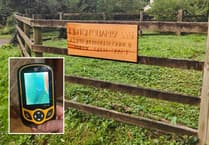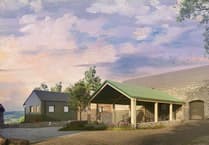A ROSS GAZETTE EXCLUSIVE
A LOCAL man who unearthed a Neoclassical bust that had been on display at Goodrich Court, has identified who it depicts.
The bust, one of four, depicts the great historical painter James Barry, (1741-1806) and is the work of Joseph Panzetta who created the sculptures in 1818 using Coade stone, which is resistant to weathering.
James Barry was born in Cork in Ireland and as an artist worked in Dublin, Paris, Rome, Florence and Venice, latterly under the patronage of Edmund and William Burke.
In London, Barry not only became a member of the Royal Academy of Arts but also its professor of painting, having created six canvases for the Great Room at the headquarters of the Royal Society of Arts.
The bust of James Barry has natural hair, rather than a wig, with a simple draped garment. It is based on a portrait by William Evans.
Barry died on February 22, 1806. His body lay in state at the Society of Arts and was later interred in the artists’ corner of St Paul’s Cathedral.
Ross-on-Wye man Graham explained that he was gardening for a woman who was moving into a nursing home and told him about the bust, and that it originated from Goodrich Court, and that if he retrieved it, he could have it.
Graham said that the project to clean the bust and find more about it soon became a passion, and it wasn’t long before the classical details started showing itself.
On the side of the bust was the lettering Coade, London 1818, which suggests the bust had been created by Eleanor Coade’s team of artists using a special ceramic material.
Graham said: “After the hours of work I put into cleaning the bust, it’s amazing how it looks, almost as good as new.
“It was a bust that could have been placed in a special niche within Goodrich Court. However, there is no obvious way to say who the bust depicts, but my guess it would be somebody important.
“I originally though it was either Sir Samuel Rush Meyrick who built Goodrich Court or its architect Edward Blore, but equally as the subject is dressed in a Neoclassical style, it could have easily been a historical figure from the past.
“The bust, despite its age and how it’s been kept over the decades, is in remarkably good condition, but it has a smacked nose, probably as a result of falling over.”
Graham has spent the last seven months undertaking an investigation into the bust when he chanced upon an article focusing on Crawford Municipal Art Gallery in Cork, Ireland and spotted an exact likeness to his bust.
He also discovered that the artist had created four busts, one of which is at St Paul’s Cathedral, with one being held by Crawford Municipal Art Gallery and one is owned by the Society of Arts and now thinks he has the fourth missing bust.
Graham said that since the discovery of who the bust depicts, it no longer graces his garden as it has been moved inside for security reasons.




Comments
This article has no comments yet. Be the first to leave a comment.